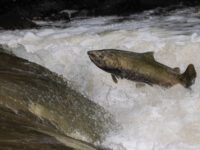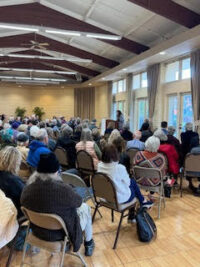With crews arriving from as far away as Greece and New Zealand, California firefighters are struggling to contain hundreds of wildfires burning throughout the state – while trying not to leave unburned areas unprepared.
“We’re in good shape locally – stretched, but able to handle any sort of contingency in our community,” Sonoma Valley Fire and Rescue Authority Chief Phillip Garcia told the Sonoma Disaster Council July 10.
Nine SVFRA firefighters and two engines were deployed June 21 to fight lightning-sparked fires in Humboldt, Mendocino and Butte Counties. As of press time Tuesday, one SVFRA engine was returning with four weary firefighters and a broken leaf-spring suspension. The other engine, on permanent loan from the state Office of Emergency Services and under the command of SVFRA Capt. Mike Bruno and a crew of three, is still on the fire line in Butte County.
Smoke from the California fires as captured by MODIS (Moderate Resolution Imaging Spectroradiometer) on Monday, July 15.
Photo Submitted.
Smoke from the California fires as captured by MODIS (Moderate Resolution Imaging Spectroradiometer) on Saturday, July 12.
Photo Submitted.
By July 10, 24 SVFRA employees had rotated through the two assignments, and departments within Sonoma County (both local jurisdictions and area Cal Fire stations) had contributed 151 personnel, 32 engines and a water tender to the effort.
All told, as of Tuesday 19,493 firefighters, 1,347 engines and 371 water tenders – along with 206 bulldozers and 121 helicopters – were still struggling to contain 96 active fires, down from a peak of 2,010 at the end of June. More than 866,000 acres had been consumed throughout California, along with 100 homes and 130 other buildings.
Garcia echoed his statewide colleagues’ comments about the unprecedented 2008 fire season – “We don’t usually see these conditions until August or September” – and described 30 to 40 blazes burning unattended due to lack of resources.
“There’s just nobody left in the state to fight those fires,” he said. “Essentially, the whole Valley, the whole county, is depleted.”
California’s fire districts are knit together by a series of “mutual aid” agreements, which map out the resources each district can turn to in time of need. But under the current circumstances, agencies are having to turn to their own reserve apparatus and “overstaff” during the day while keeping an eye on their neighbors. In SVFRA’s case, that means raising from 13 to 17 the number of daily personnel to staff an additional engine on “red flag,” high fire-danger days.
Garcia illustrated his mutual-aid point with the July 4 fire that burned seven acres of hillside northwest of Sonoma before being contained within an hour and a half. Four Valley agencies were aided by a half-dozen others as well as Cal Fire for a force that included 23 engines, two helicopters and four air tankers. He said the “quick attack” worked well in Sonoma – but more remote areas are still waiting.
Meanwhile, property owners unaffected by the current crisis can take steps to stay that way – or make it easier for firefighters should the inevitable happen. Garcia said Tuesday that clearing brush from under trees and around structures and being aware of the dangers of open fires is still key, as is mowing in the early morning – as long as the engine is equipped with a spark arrestor.
“I can’t think of anything in terms of fire prevention concerns that’s unusual at this time of year,” he said. “The last couple of days you could see a marked difference – the air’s cooler, the moisture’s higher. But it changes constantly.”

Smoke from the California fires as captured by MODIS (Moderate Resolution Imaging Spectroradiometer) on Thursday, July 10.
Photo Submitted.








